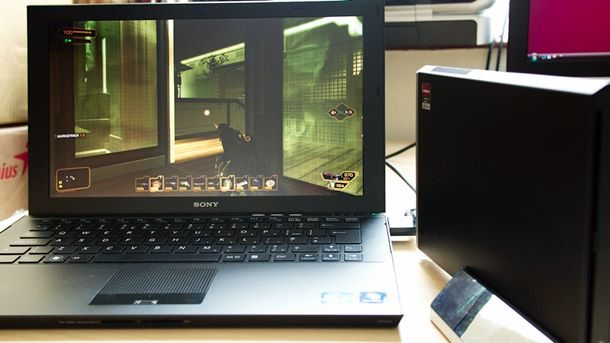External Graphics: The Way Forward For Gaming Laptops?
The Future of External Graphics
External graphics is a developing field of the computing industry. It has yet to take off because of the previously mentioned issue with finding a cheap but widespread interface that can provide enough bandwidth for graphics cards to function on. However, things look set to change: starting with Thunderbolt. Although Thunderbolt is currently very expensive ($10 per controller compared to $1 for USB 3 and $0.1 for USB 2) it offers us the best chance to provide large bandwidth to the masses and ultimately give people the option to run external graphics in a simple and user friendly way. However, it must be stressed the vast majority of current solutions are based on the ExpressCard interface which provides 5Gb/s bandwidth which is the same as USB 3.0, so USB 3.0 looks to be the ‘cheaper alternative’ to Thunderbolt when external graphics take off.
In the most recent times we have seen a couple of branded solutions arise one courtesy of Sony over USB 3.0 and one courtesy of MSI over Thunderbolt. Many of companies have prototypes and designs but these two are perhaps the best known and publicized examples.
Sony recently trialed the idea of external graphics with its Sony Vaio laptops. As you may know they take a very slim and small design which only has good battery life due to the omission of any high end graphics hardware. But ultimately the laptop is capable of ‘laptop duties’ such as video playback without the requirement for any external graphics. Once you bring gaming into the equation, which lets face it a lot of laptop owners tend to want to do even if they cannot, the need for external graphics is obvious. Sony’s prototype USB 3.0 dock provides external discrete class graphics, a HD 6650 in this instance, in addition to an optical drive and some USB ports. This allows a relative gaming incapable laptop to take on Crysis and DeusX HR at medium settings on the 1600 by 900 monitor. Impressive giving the current standard of laptop graphics which ranges from the abysmal to the ‘acceptable.
You can read a more detailed report of Sony’s creation here.

In the absolute most recent news MSI have been improving on the external graphics offering by adapting Thunderbolt into their designs which gives double the bandwidth of USB 3.0, i.e 10Gb/s over 5Gb/s. MSI’s GUS II design uses a PCI-E 16X lane connected to a laptop (in this case a MacBook) via Thunderbolt but powered separately (Thunderbolt only supplies 10W, not enough for even the weakest discrete card). But like the ViDock design this only sends the images and information to an external monitor. However, on the face of things you get the ability to run a graphics card on the equivalent of a PCI-E 2.0 2X slot which gives you enough bandwidth to run decent cards up to a HD 6770 which is surely enough for most laptop gamers, if you want better gaming capability than that it surely makes more sense to just buy a desktop PC. But currently Thunderbolt is a predominantly MacBook offering, Windows based laptop owners may have to wait a while for something like this to arrive. Expect to see a lot more where this came from when Ivy Bridge based notebooks (supporting Thunderbolt) arrive later this year.
Read more about the MSI GUS II here.










Sounds good but still a bit of work, seems to defeat the object of a laptop if you then need an external graphics and monitor, the sony may be better if you can run it of USB3 no doubt USB4 could even follow in the future exciting though but any thing can happen I suppose. Will need it's own power supply.
"which only has good battery life due to the admission of any high end graphics hardware"
I think you mean omission…
Thank you!
where can buy it?
Very well written, and easily understandable by even those not very knowledgeable about computer hardware. Thankyou!
Or you can just get a gaming laptop that isn’t a piece of shit.
Why is nobody making a docking station that you can put a normal card in? I remember many years ago, before HP bought Compaq, they had a docking station that would fit PCI cards. Why don’t manufacturers use their docking station ports on the motherboard to pipe PCIe x16 slot to a large docking station solution that you can install a graphics card in. It’s been over 10 years since I saw these drop out of use but they were very good, and have been much missed by those that used to have twin displays they could game on with their work laptops.
Coz they’re idiots. I’ve always wondered why they never did too